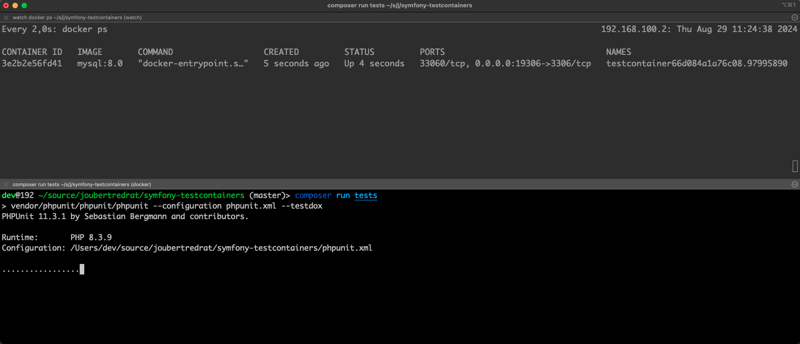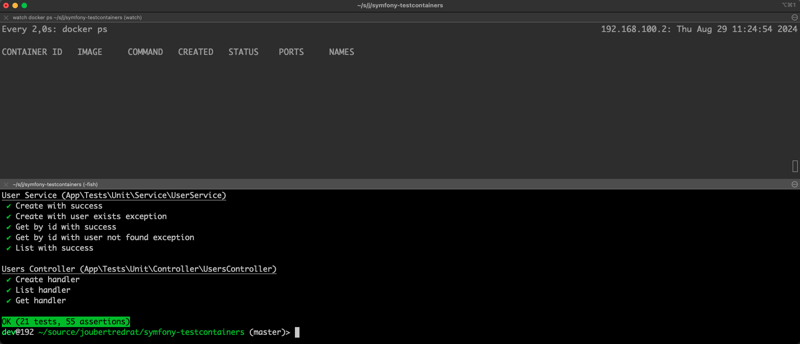Integration Tests in Symfony with Testcontainers
Disclaimer: I am not a divine entity. What I say is not an absolute truth. Don't be afraid to question even the world, because it could be wrong, not you.
Today it's no secret to anyone the importance of automated tests to maintain the quality and integrity of your software and we usually talk a lot about unit tests, however, today, we will focus more on integration tests in the Symfony Framework.
I'm out of patience, show me the code!
Okay okay! If you don't have the patience to read this article, I have a test project implementing this article at the link below.
https://github.com/joubertredrat/symfony-testcontainers
Symfony Framework and Integration Tests
Today, the Symfony Framework is one of the most mature frameworks in the PHP universe and it has several well-implemented solutions, such as for integration tests, for example. However, personally I always found that although it is easy to do the integration tests themselves, providing external dependencies for the tests was not always so easy, like databases for example.
Even with the emergence of Docker, I still realized the need to provision external dependencies in some way for testing, however, there is a very interesting solution that can make this step much easier, Testcontainers.
Testcontainers
Testcontainers is an open source framework that allows you to more easily provision any external dependency you need using Docker, such as a database, message broker, caching systems, or practically any container dependency.
The big difference between Testcontainers in relation to Docker compose or any other form of container provisioning is that you can program container provisioning, and today it already has support for Golang, Java, .NET, Node.js, Python , Rust, several other languages, and of course, PHP!
My first contact with Testcontainers was with a Golang project and I really liked the ease of provisioning a MongoDB container to carry out my tests in the repositories and after that, I decided to do the same in a personal project that I have in PHP using the Symfony Framework.
Symfony + Testcontainers = ❤️
One of the great advantages of Symfony is precisely the support for tests in PHPUnit by providing a fully functional Kernel to perform the necessary bootstrap for tests.
Although Testcontainers supports PHP, the implementation is newer and you can check it out at https://github.com/testcontainers/testcontainers-php.
Below we have an implementation of a MySQL 8.0 container, which is the external dependency of this project, in addition to booting the Symfony Kernel, creating the database and schema.
class IntegrationTestCase extends KernelTestCase
{
protected static ?MySQLContainer $container = null;
public static function setUpBeforeClass(): void
{
parent::setUpBeforeClass();
if (!static::$container) {
static::$container = MySQLContainer::make('8.0', 'password');
static::$container->withPort('19306', '3306');
static::$container->run();
$kernel = self::bootKernel();
$container = $kernel->getContainer();
$application = new Application($kernel);
$application->setAutoExit(false);
$application->run(
new ArrayInput(['command' => 'doctrine:database:create', '--if-not-exists' => true])
);
$entityManager = $container->get('doctrine')->getManager();
$metadata = $entityManager->getMetadataFactory()->getAllMetadata();
$schemaTool = new SchemaTool($entityManager);
$schemaTool->dropSchema($metadata);
$schemaTool->createSchema($metadata);
}
}
public static function tearDownAfterClass(): void
{
parent::tearDownAfterClass();
if (static::$container instanceof MySQLContainer) {
static::$container->remove();
}
}
With this, we have the base class for the classes that will actually execute the tests, as in the example below.
class UserRepositoryTest extends IntegrationTestCase
{
public function testSave(): void
{
$user = new User();
$user->setName('John Doe');
$user->setEmail('john@doe.local');
$repo = $this->getRepository();
$repo->save($user, true);
self::assertNotNull($user->getId());
self::assertIsInt($user->getId());
self::assertTrue($user->getId() > 0);
}
public function testGetByEmail(): void
{
$user = new User();
$user->setName('John Doe');
$user->setEmail('john2@doe.local');
$repo = $this->getRepository();
$userNotFound = $repo->getByEmail($user->getEmail());
self::assertNull($userNotFound);
$repo->save($user, true);
$userFound = $repo->getByEmail($user->getEmail());
self::assertEquals($user->getEmail(), $userFound->getEmail());
}
protected function tearDown(): void
{
parent::tearDown();
$connection = $this
->getContainer()
->get('doctrine')
->getManager()
->getConnection()
;
$connection->executeStatement('TRUNCATE TABLE users');
}
protected function getRepository(): UserRepository
{
return $this->getContainer()->get(UserRepository::class);
}
}
When running the test suite, you will notice a delay in finishing the tests, however, this is normal, because during this process, Testcontainers is provisioning the container that you defined to use in the tests.


Finally, with this ease, you can even try to do crazy things, like 100% coverage. Don't believe it? You can see it yourself at https://joubertredrat.github.io/symfony-testcontainers.
So that's it, until next time!
The above is the detailed content of Integration Tests in Symfony with Testcontainers. For more information, please follow other related articles on the PHP Chinese website!

Hot AI Tools

Undresser.AI Undress
AI-powered app for creating realistic nude photos

AI Clothes Remover
Online AI tool for removing clothes from photos.

Undress AI Tool
Undress images for free

Clothoff.io
AI clothes remover

Video Face Swap
Swap faces in any video effortlessly with our completely free AI face swap tool!

Hot Article

Hot Tools

Notepad++7.3.1
Easy-to-use and free code editor

SublimeText3 Chinese version
Chinese version, very easy to use

Zend Studio 13.0.1
Powerful PHP integrated development environment

Dreamweaver CS6
Visual web development tools

SublimeText3 Mac version
God-level code editing software (SublimeText3)

Hot Topics
 1658
1658
 14
14
 1415
1415
 52
52
 1309
1309
 25
25
 1257
1257
 29
29
 1231
1231
 24
24
 How does session hijacking work and how can you mitigate it in PHP?
Apr 06, 2025 am 12:02 AM
How does session hijacking work and how can you mitigate it in PHP?
Apr 06, 2025 am 12:02 AM
Session hijacking can be achieved through the following steps: 1. Obtain the session ID, 2. Use the session ID, 3. Keep the session active. The methods to prevent session hijacking in PHP include: 1. Use the session_regenerate_id() function to regenerate the session ID, 2. Store session data through the database, 3. Ensure that all session data is transmitted through HTTPS.
 Explain different error types in PHP (Notice, Warning, Fatal Error, Parse Error).
Apr 08, 2025 am 12:03 AM
Explain different error types in PHP (Notice, Warning, Fatal Error, Parse Error).
Apr 08, 2025 am 12:03 AM
There are four main error types in PHP: 1.Notice: the slightest, will not interrupt the program, such as accessing undefined variables; 2. Warning: serious than Notice, will not terminate the program, such as containing no files; 3. FatalError: the most serious, will terminate the program, such as calling no function; 4. ParseError: syntax error, will prevent the program from being executed, such as forgetting to add the end tag.
 PHP and Python: Comparing Two Popular Programming Languages
Apr 14, 2025 am 12:13 AM
PHP and Python: Comparing Two Popular Programming Languages
Apr 14, 2025 am 12:13 AM
PHP and Python each have their own advantages, and choose according to project requirements. 1.PHP is suitable for web development, especially for rapid development and maintenance of websites. 2. Python is suitable for data science, machine learning and artificial intelligence, with concise syntax and suitable for beginners.
 Explain secure password hashing in PHP (e.g., password_hash, password_verify). Why not use MD5 or SHA1?
Apr 17, 2025 am 12:06 AM
Explain secure password hashing in PHP (e.g., password_hash, password_verify). Why not use MD5 or SHA1?
Apr 17, 2025 am 12:06 AM
In PHP, password_hash and password_verify functions should be used to implement secure password hashing, and MD5 or SHA1 should not be used. 1) password_hash generates a hash containing salt values to enhance security. 2) Password_verify verify password and ensure security by comparing hash values. 3) MD5 and SHA1 are vulnerable and lack salt values, and are not suitable for modern password security.
 What are HTTP request methods (GET, POST, PUT, DELETE, etc.) and when should each be used?
Apr 09, 2025 am 12:09 AM
What are HTTP request methods (GET, POST, PUT, DELETE, etc.) and when should each be used?
Apr 09, 2025 am 12:09 AM
HTTP request methods include GET, POST, PUT and DELETE, which are used to obtain, submit, update and delete resources respectively. 1. The GET method is used to obtain resources and is suitable for read operations. 2. The POST method is used to submit data and is often used to create new resources. 3. The PUT method is used to update resources and is suitable for complete updates. 4. The DELETE method is used to delete resources and is suitable for deletion operations.
 PHP: A Key Language for Web Development
Apr 13, 2025 am 12:08 AM
PHP: A Key Language for Web Development
Apr 13, 2025 am 12:08 AM
PHP is a scripting language widely used on the server side, especially suitable for web development. 1.PHP can embed HTML, process HTTP requests and responses, and supports a variety of databases. 2.PHP is used to generate dynamic web content, process form data, access databases, etc., with strong community support and open source resources. 3. PHP is an interpreted language, and the execution process includes lexical analysis, grammatical analysis, compilation and execution. 4.PHP can be combined with MySQL for advanced applications such as user registration systems. 5. When debugging PHP, you can use functions such as error_reporting() and var_dump(). 6. Optimize PHP code to use caching mechanisms, optimize database queries and use built-in functions. 7
 Explain Arrow Functions (short closures) introduced in PHP 7.4.
Apr 06, 2025 am 12:01 AM
Explain Arrow Functions (short closures) introduced in PHP 7.4.
Apr 06, 2025 am 12:01 AM
The arrow function was introduced in PHP7.4 and is a simplified form of short closures. 1) They are defined using the => operator, omitting function and use keywords. 2) The arrow function automatically captures the current scope variable without the use keyword. 3) They are often used in callback functions and short calculations to improve code simplicity and readability.
 PHP in Action: Real-World Examples and Applications
Apr 14, 2025 am 12:19 AM
PHP in Action: Real-World Examples and Applications
Apr 14, 2025 am 12:19 AM
PHP is widely used in e-commerce, content management systems and API development. 1) E-commerce: used for shopping cart function and payment processing. 2) Content management system: used for dynamic content generation and user management. 3) API development: used for RESTful API development and API security. Through performance optimization and best practices, the efficiency and maintainability of PHP applications are improved.




